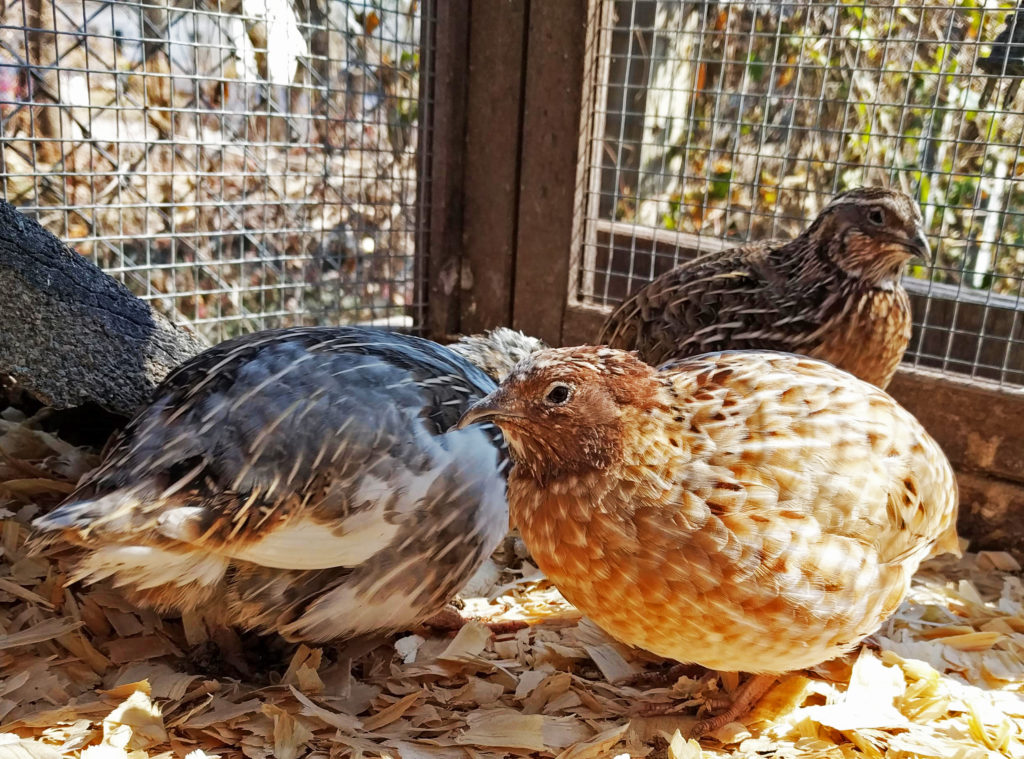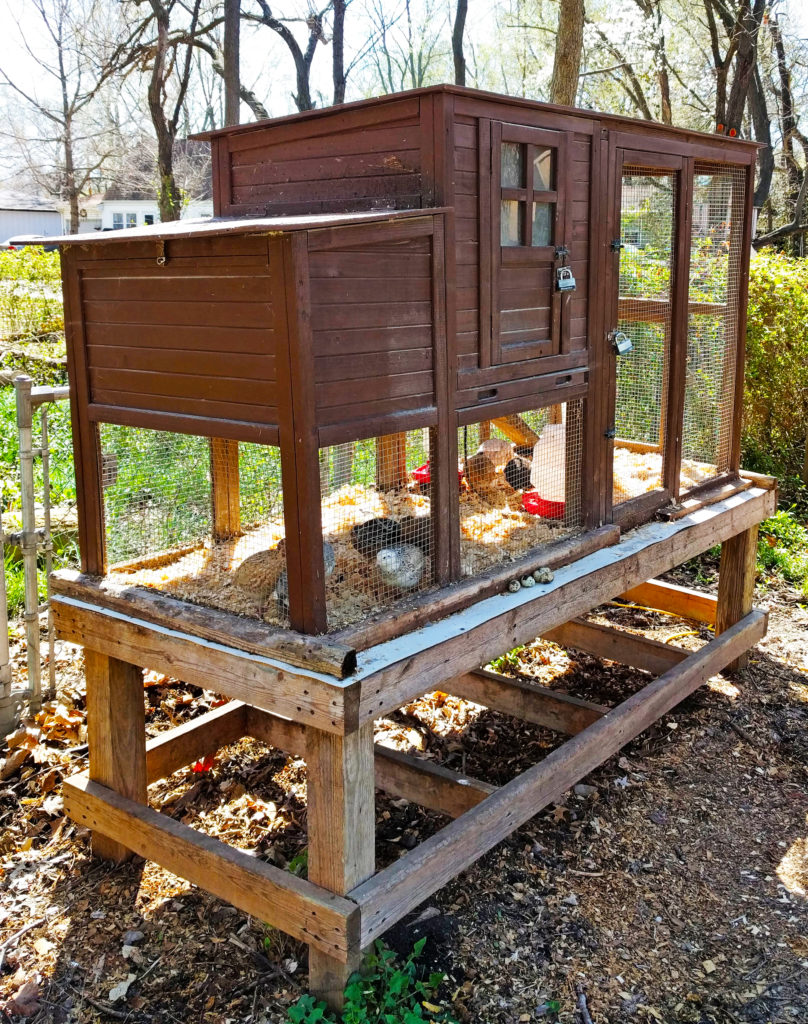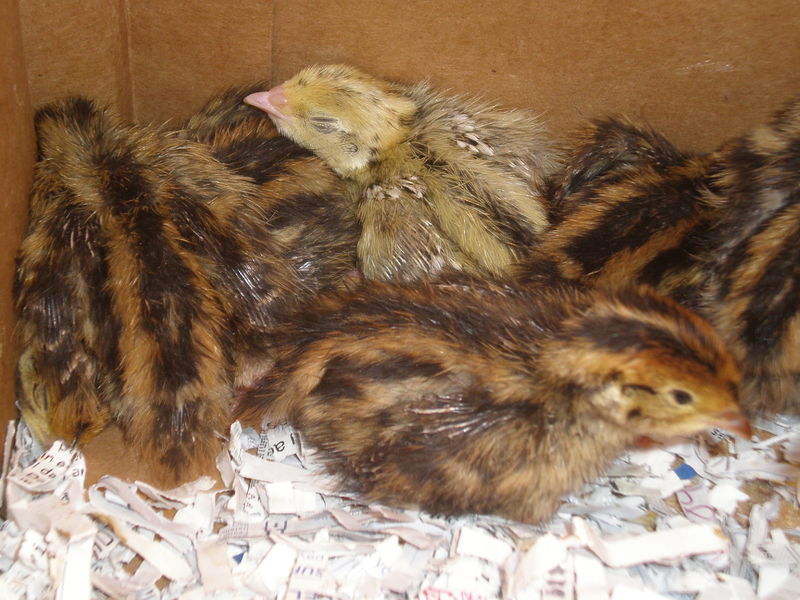Are Coturnix Quail right for you? Quail owner, Kelly Bohling, shares her knowledge of these small birds and how to keep them in this Featured Article.
Japanese quail (Coturnix japonica) are increasingly popular meat and egg sources for modern, city-dwelling homesteaders. Quail are especially well-suited for urban settings, as they flourish in small spaces and go largely unnoticed by neighbors. Their call is similar to a red-winged blackbird, and blends in well with the neighborhood soundscape. Quail are colorful birds, efficient eaters, and dependable layers. Your friends and neighbors will soon be asking if you have any quail eggs to spare!

Beautiful Plumage
From an aesthetic perspective, Coturnix quail come in a wide range of beautiful colors and patterns: white to speckled brown, golden, silver, and more. These color variations have many names such as Tibetan, Italian, Roux, Manchurian, Red Golden, Tuxedo, and Platinum. But keep in mind that despite the surface variations, Coturnix quail are all of the same genus and the Japanese quail (Coturnix japonica) are just one species within that genus.
Housing Tiny Birds
The size of a Coturnix quail can range from a few ounces to nearly a pound, depending on the species. They are much smaller than chickens and extremely efficient considering the space, food, and water that they require. For instance, quail space requirements are 1-square-foot per bird, while chickens need 2- to 3-square-feet per bird. Quail live happily together in large colonies, but it is important to keep them at a ratio of 4 or 5 females to one male. More males can lead to aggressive behavior and should be avoided for the health and well-being of all the birds.

Coturnix quail can be kept either on wire, on the ground, or in solid-floored coops. While quail are not typically broody, they do occasionally hatch their young when provided with a solid-floored coop or a coop on the ground, since it emulates their wild habitat as ground birds.
But Maybe Not the Tractor
As helpful as they are for eating unwanted garden insects, quail are not the best candidates for poultry tractors. Unlike chickens, their small size and surprising speed make moving an open-bottomed tractor very difficult, and your birds would be vulnerable to natural predators such as raccoons and opossums. It is best to have quail in a permanent, enclosed coop and run.

They also shouldn’t be allowed to free-range in the yard or the garden like chickens because they can escape through very small openings in fences, fly quickly over tall barriers, and are extremely adept at hiding. Their coloring, while pretty to look at, camouflages them perfectly in brush and foliage, and makes them very hard to find.
What They Eat
Quail require a high-protein diet, and adults do well with a 22 percent protein feed for meat or game birds, commonly available at local farm supply stores. Chicks, too, will need a higher protein feed, but only for the six weeks between hatching and maturation. Each adult quail will consume about 18 grams of feed per day, and if they have an efficient, low-waste feeder, a 40-pound bag will last 20 birds approximately 2 months. A small plastic box or bucket can be turned into an effective feeder by cutting small holes a couple of inches from the bottom, only large enough for the quail to stick their heads into. Cover the cut edges with duct tape to protect your quail. They like to scratch and “forage” in their pellets and, if allowed, they will quickly spread their food everywhere. It is the main source of potential food waste, and can result in a foul-smelling coop when the high-protein food comes in contact with water. A box feeder lets them eat as much food as they want without scattering their feed; you will appreciate the cleaner coop.

Versatile Birds
From melon rinds and innards, to stale chunks of bread, quail are happy to eat vegetables, fruits and bread scraps. Their own egg shells can be dried in the oven at a low temperature, ground up, and added back into their food as a calcium supplement. You can collect cabbage worms, grubs, larvae and other unwanted bugs from your backyard to provide a varied smorgasbord for your quail and keep such pests out of the garden.
Quail, in turn, provide egg shells which can be crushed and added to your garden as slug and snail deterrents, while quail droppings can be added to your compost pile. Like chicken manure, quail dung should not be added directly to your garden, where it might “burn” your plants, but should be allowed to decompose.
Clean Water
Quail need their water changed daily. A single gallon waterer is enough to supply 20 birds or more, but they will often dirty their water by the end of the day. Like the feeder, placing the waterer above ground level (on a paver stone or something similar) will prevent your quail scratching up dirt, coop debris, or droppings into their water. It’s also a good habit to scrub out the waterers every other day with a brush and dish soap. In freezing temperatures, have a constant source of unfrozen water for the birds. You can invest in a heated waterer, or rotate waterers around the coop (from cooler to warmer areas) to keep the water from freezing.
Brooding Babies
Coturnix quail have been bred in captivity for quite a while, and the hens have generally lost a lot of their brooding instincts. If you want to mate your birds and hatch those eggs, you will most likely need an incubator. Some owners may see this as a disadvantage to owning quail, but most look forward to hatching time. Many commercial incubator companies carry quail egg trays that are compatible with their standard models, and can still be used with automatic turners. Quail eggs require slightly different humidity and temperature levels than chicken eggs, but these parameters are well within the capability of a standard incubator. Hatching quail is a uniquely wonderful experience, and they mature quickly from 1-inch fluff balls to adults in 6 weeks. After hatching, keep the chicks in a warmed brooder. If the weather is warm, the young birds can be moved to an outside coop at 4 to 5 weeks old.

Excellent Egg Layers
Even though they may lack brooding instinct, hens are very dependable layers and start as early as 6 to 8 weeks old. In the warm months, so long as the hens receive proper food and water, they will lay an egg every day like clockwork, generally in the late afternoon or evening hours. In colder months, egg production may decrease, but it will not stop completely. Providing a heat lamp will sustain egg laying during the winter. It is best to check for eggs more often during winter months to grab them before they freeze. Once the eggs are frozen and have a cracked shell in a coop environment, they should not be eaten.
Amazing Eggs
Quail eggs are slightly higher in protein, and certain vitamins and minerals than chicken eggs; the shell is thinner but the membrane beneath the shell is thicker. This can cause some frustration in the beginning when using the eggs, whether for baking or hard boiling, but the results are worth it. Quail eggs taste much more rich and buttery than chicken eggs, mainly due to the larger yolk-to-white ratio. They are delicious additions to green salads, pasta or potato salads, curries, and they are divine when pickled. Petite devilled quail eggs will delight fellow party-goers! Selling extra eggs can help offset the cost of quail food, and during the high-yield summer months, quail can pay for themselves.
[Kelly will be back with us in July, sharing lots of information about What To Do With Quail Eggs.]

Keeping Coturnix quail requires very little time and effort in exchange for the return they provide. You will need to plan for their living quarters and feeders, but quail are very self-sufficient and hardy. With a variety of lovely colors to choose from and a steady supply of eggs, they have been the choice for many backyard farmers. Perhaps you too, will choose to keep quail!
Kelly Bohling is a native of Lawrence, Kansas. She works as a classical violinist, but in between gigs and lessons she’s out in the garden or spending time with her animals, including quail and French Angora rabbits. Kelly also spins the Angora fiber from her rabbits into yarn for knitting, which can be found in her Etsy shop, ThreeRabbitYarns. She enjoys finding ways that her animals and garden can benefit each other for a more sustainable urban homestead. https://www.instagram.com/threerabbityarns/













7 Comments
Can quail successfully cohabit with chickens?
Hello,
Quail have really different habitat needs than do chickens. Quail need low cages that are completely enclosed or they will simply fly out of the cage and leave. They prefer low brush so they can hide and build their nests, and they have different dietary needs, particularly protein. We don’t recommend trying to co-house chickens and quail.
Thank you for such a thorough and well written article. My brother in law raised quail several years ago and wasn’t happy with the experience and so I just put raising them out of my head but your article was so informative I will definitely give quail raising a chance. It was a matter of proper education and you provided that with your article-thank you again.
We have one chicken, an Is a Brown. Can we or should we add 6 quail chicks to make a flock? What is the pros and cons to a mixed flock?
Hello Susan,
Quail have really different habitat needs than do chickens. Quail need low cages that are completely enclosed or they will simply fly out of the cage and leave. They prefer low brush so they can hide and build their nests, and they have different dietary needs, particularly protein. We don’t recommend trying to co-house chickens and quail.
Can Coturnix quail be released into the wild? Can they survive?
Hi Ron,
Quail from the Coturnix genus (like the Japanese quail) have really been bred for domestication and captivity. Unlike the Bobwhite or Gambel’s quail, the hens no longer have a really solid brooding instinct and so don’t necessarily sit the nest well to hatch babies. They also may or may not really know how to forage efficiently. If you are interested raising quail to be released, you might contact Quail Forever https://quailforever.org/
for more information on raising non-Coturnix quail, and how they are released.